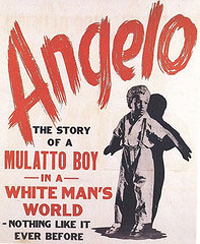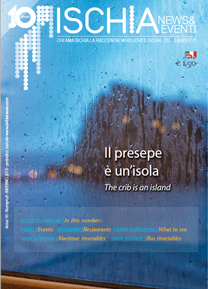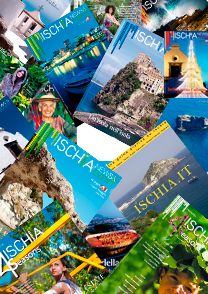
Ischia scena del film Villa Amalia - veduta su San Pancrazio
Angelo
Member of the instance is the neorealist film "Angelo", of 1950, directed by Francesco De Robertis, who, inspired by true events, is intended as a call for justice to the resolution of one of the most difficult problems that the war has involved. It is the issue of racial difference, he had already found a place, and in the same terms in the song "tammurriata nera", certainly affect the sensitivity popular. Ischia with its natural location and with the help of the "pharmacy Mirabella" and "Caffè" of the Signorine "Fiurinte" offers settings to the events narrated in the film, also being a victim of social upheaval, related the barbarian raids occurred in the past. The film tends to be positive, but the thorny topic makes a show is not suitable for young people (Bianchi, 1950) can be considered a seemingly conventional melodrama, but who knows how to address the issue of racism with an intensity and an originality able to avoid any loophole to bring out the problem in its entirety. The double soundtrack, made of Neapolitan music and American music and jazz blouses, emphasizes the incompatibility of two opposed universes, although both marked by exclusion. (Mereghetti, 2002).

- Title ANGELO
- Release date(s) 1950
- Genere WAR FILM
- Running time 85 Min
- Production SCALERA FILM
- Direction FRANCESCO DE ROBERTIS
- Photography: Carlo Bellero
- Music: Annibale Bizzelli
Plot
During the war, a street musician, Matteo, commits a theft and was sentenced to five years. While in prison, his wife dies in childbirth. Released from prison, goes in search of the child, care of the Sisters, but the baby is a little negro with curly hair, the result of the violence, in spite of himself, his wife, during the Allied occupation. Very shaken, wounded in the most intimate feelings, Matteo would repudiate the child, but there is nothing to do in the little mulatto is legally his son. And little by little, almost without knowing it, the man approaches the child, which is so cute, so affectionate. When the child falls ill, Matteo, trembling, is surprised to pray for his salvation. Now he loves so much that he is renouncing his beloved rather than separate from Angelo. But one day he has a negro, brother of the true father of Angelo, who died in the war. He wants to take the child with him, but is willing to leave it to Matthew, when the grandson of happiness requires it. But Angelo, impressed by the way of his uncle, the melancholic songs, hear the call of the race and clings to him. With tears in his eyes, Matteo lets go.
Ischia scena del film Villa Amalia - veduta su San Pancrazio
Doctor Antonio
Forerunner of the neo-realistic vein appears to be the film "Dottor Antonio" of '39, directed by Enrico Guazzoni, which deals with the 1848 uprising. The main character, Dr. Antonio, was sentenced to many years in prison, right in the Aragonese Castle, which in fact, in the past, was a place of detention. Among his imprisoned for political offenses, they may include less than 62, the most famous: Nicola Prisco (1820-1901), Michele Pironti (1814-1885) and Carlo Poerio (1803-1867), which you spent a period between 1851 and 1852, people of great talent and culture were, with the unification of Italy, also elected deputies, and gave an active contribution to the cause of National Unity and staff. (D'Ambra, 1987). The critical, however, has not been very benevolent towards the final yield of the film. Given the importance and the possibility of the film subject, might have to perform better, but the beginning is slow and the interpretation of the actors appears to be no accents. (Di Meglio, 1937).

- Title DOCTOR ANTONIO
- Release date(s) 1939
- Genre DRAMA FILM
- Running time 98 Min
- Based on THE HOMONYMOUS NOVEL BY GIOVANNI RUFFINI
- Production GUAZZONI - PIETRO MANDER
- Direction ENRICO GUAZZONI
- Photography: Massimo Terzano
- Music: Giovanni Fusco, Umberto Mancini
Plot
During the riots of '48 in Italy, a doctor has the opportunity to meet and heal a serious wound to an English lady. Between the two lovers fell in love, which is interrupted by the sudden departure of the doctor to Naples, where he takes part in the revolt. Arrested, he was sentenced to many years in prison. But the English girl manages to bribe a jailer and thereby to facilitate the escape of her boyfriend.
Ischia scena del film Il Corsaro Nero - Baia del Castello Aragonese
The Black Corsair
"The Black Corsair" is based on the novel by Emilio Salgari, in which our Pithecusa is smuggled to a Caribbean island. It's a popular movie, but made no economy, with real ships and a collision of excellent effect. The island offers, as a backdrop to epic duels, views of the sea and beautiful and terrible storms. Of this first film the director recalls the scenes "scenes shot in Ischia, a beautiful island that I have in mind for its natural beauty. The climate of Ischia regenerated me a lot. We had to know the beautiful pine forests and to observe a peaceful people to his farm work. In the film I called for a small part the comic Polidor (...) ". In the film, it was important to the long sequence in which Ciro Verratti, Lord of Ventimiglia, riding arena to the enchanting Maronti beach, for the first time presented to an audience of potential new tourists great islanders.

- Title THE BLACK CORSAIR
- Release date(s) 1938
- Genre ADVENTURE FILM
- Running time 125 Min
- Based on THE HOMONYMOUS NOVEL BY EMILIO SALGARI
- Production GIORGIO GENESI PER ARTISTI ASSOCIATI
- Direction AMLETO PALERMI
- Photography: Alberto Spagnoli
- Editing: Alberto Gallitti
- Music: Maurizio De Angelis, Guido De Angelis

















